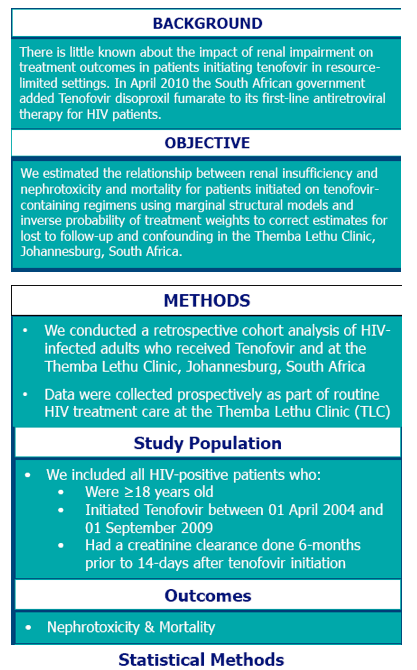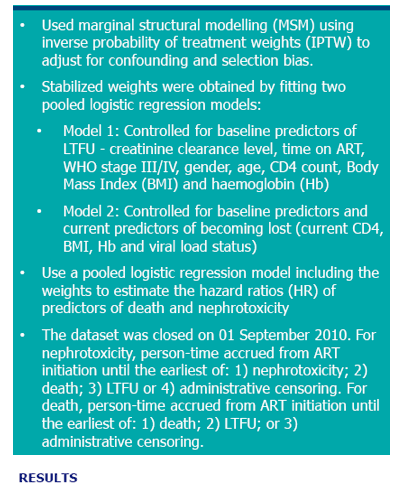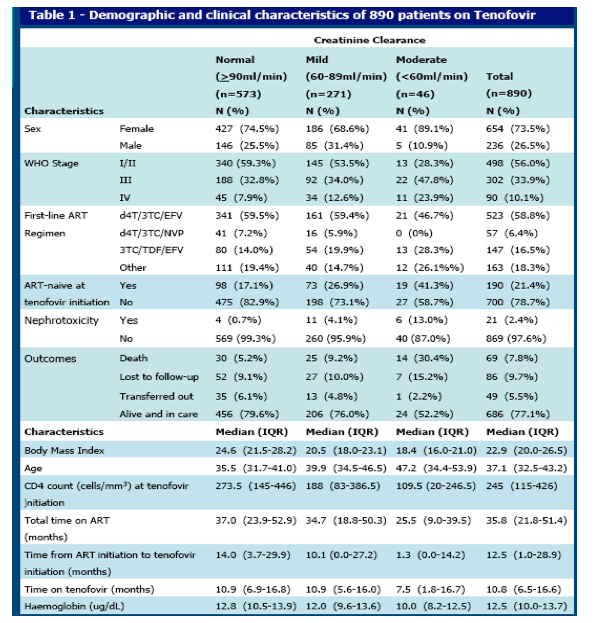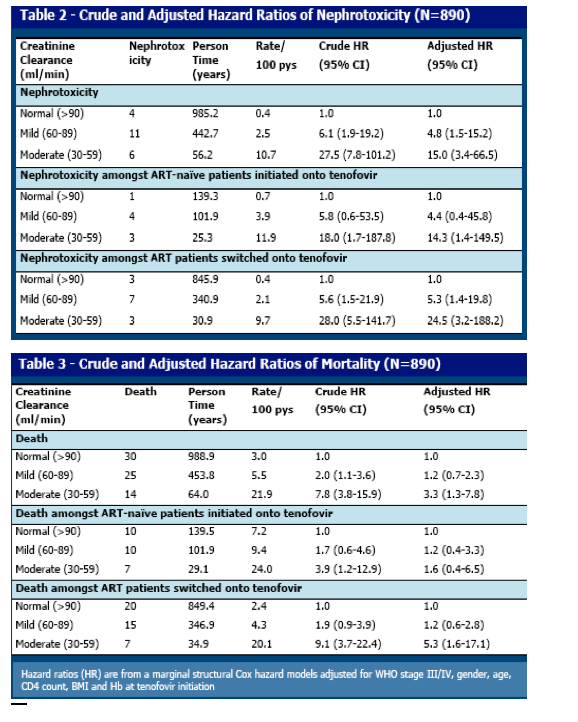 |
 |
 |
| |
Renal Insufficiency, Nephrotoxicity, and Mortality among HIV-infected Adults on TDF in a South African Cohort: A Marginal Structural Models Analysis - pdf attached
|
| |
| |
Reported by Jules Levin
CROI 2011 March 2 Boston

Alana Brennan*1,2, D Evans1, M Fox1,2,3, M Maskew1, P Ive1, S Naicker1, and I Sanne1,4
1Faculty of Hlth Sci, Univ of the Witwatersrand, Johannesburg, South Africa; 2Ctr for Global Hlth and Devt, Boston Univ, MA, US; 3Boston Univ Sch of Publ Hlth, MA, US; and 4Right to Care, Johannesburg, South Africa
Background: In April 2010 the South African government added tenofovir disoproxil fumarate (TDF) to its public-sector first-line ART for HIV patients. We set out to analyze the relationship between renal insufficiency at TDF initiation and nephrotoxicity and mortality.
Methods: We conducted a retrospective cohort analysis of HIV-infected adults who received TDF and had a creatinine clearance done at initiation of TDF at the Themba Lethu Clinic, Johannesburg, South Africa, from April 2004 to September 2009. We estimated the relationship between renal insufficiency and nephrotoxicity and mortality for patients newly initiated or switched onto TDF-containing regimens using marginal structural models and inverse probability of treatment weights to correct estimates for loss to follow-up and confounding.
Results: Of 890 patients who initiated on TDF, 573 (64.4%) had normal creatinine clearance (≥90 mL/minute), 271 (30.4%) had mild (60 to 89 mL/minute), and 46 (5.2%) had moderate (30 to 59 mL/minute). Of the total, 21 (2.4%) experienced nephrotoxicity, 69 (7.8%) died and 89 (10%) were lost during 48 months of follow-up. Median time to nephrotoxicity and death was 3.6 (IQR 1.0 to 12.5) and 2.6 months (IQR 0.9 to 5.3), respectively. Rates of nephrotoxicity for patients with normal, mild, and moderate renal insufficiency was 0.4/100 person-years, 2.5/100 person-years, and 10.7/100 person-years, respectively. Mortality rates increased with decreasing creatinine clearance levels (normal 3.0/100 person-years, mild 5.5/100 person-years, and moderate 21.9/100 person-years). Patients with mild (HR 4.2, 95%CI 1.3 to 13.2) or moderate (HR 11.3, 95%CI 2.3 to 54.9) creatinine clearance vs normal were at greatest risk of nephrotoxicity, while those with mild (HR 1.2, 95%CI 0.7 to 2.3) or moderate (HR 3.3, 95%CI 1.4 to 7.9) creatinine clearance vs normal were at increased risk of death by 48 months. Patients ≥40, those with low CD4 counts (<200 cells/mm3), those with low hemoglobin, patients with WHO stage III/IV and those ART-naive at TDF initiation were also at increased risk of nephrotoxicity during follow-up. Predictors were similar for death with the addition of males and those with low body mass index being at greater risk of mortality.
Conclusions: Much of the incident renal dysfunction in TDF-treated patients is likely related to preexisting renal pathology, which may be exacerbated by TDF. With expanded use of TDF, screening for renal insufficiency prior to TDF initiation is essential to reduce nephrotoxicity.




|
| |
|
 |
 |
|
|